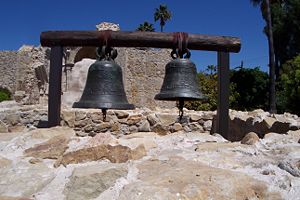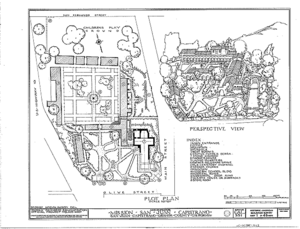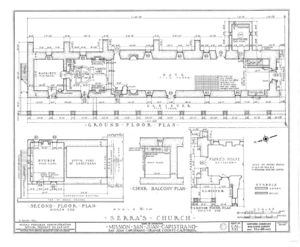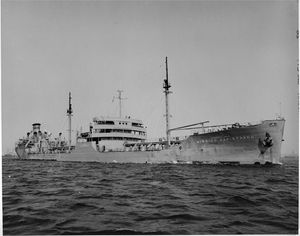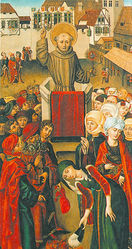Mission San Juan Capistrano/Gallery: Difference between revisions
imported>Robert A. Estremo No edit summary |
imported>Robert A. Estremo mNo edit summary |
||
| Line 6: | Line 6: | ||
Image:A Lincoln.png|{{A Lincoln.png/credit}}<br/>President Abraham Lincoln's signature as it appeared on the United States Patent that restored the Mission property to the Catholic Church in 1865. This is one of the few documents that the President signed as "''A. Lincoln''" instead of his customary "''Abraham Lincoln''." <ref name="engelhardt169">Engelhardt 1922, p. 169</ref> | Image:A Lincoln.png|{{A Lincoln.png/credit}}<br/>President Abraham Lincoln's signature as it appeared on the United States Patent that restored the Mission property to the Catholic Church in 1865. This is one of the few documents that the President signed as "''A. Lincoln''" instead of his customary "''Abraham Lincoln''." <ref name="engelhardt169">Engelhardt 1922, p. 169</ref> | ||
Image:San Juan Capistrano 1880 painting.jpg|{{San Juan Capistrano 1880 painting.jpg/credit}}<br/>''Misión San Juan de Capistrano''. The 1880 work depicts the rear of the ruined "Great Stone Church" as well as part of the mission's ''campo santos''. A portion of "Serra's Church" is also visible at right. | Image:San Juan Capistrano 1880 painting.jpg|{{San Juan Capistrano 1880 painting.jpg/credit}}<br/>''Misión San Juan de Capistrano''. The 1880 work depicts the rear of the ruined "Great Stone Church" as well as part of the mission's ''campo santos''. A portion of "Serra's Church" is also visible at right. | ||
Image:MSJC by John Gutzon-Borglum.jpg|{{MSJC by John Gutzon-Borglum.jpg/credit}}<br/>An 1894 painting | Image:MSJC by John Gutzon-Borglum.jpg|{{MSJC by John Gutzon-Borglum.jpg/credit}}<br/>An 1894 painting features a wildly-improbable steeple over the entrance of San Juan Capistrano's "Great Stone Church" (it was incorrectly believed to portray the way the church looked before the 1812 earthquake; archaeological excavations in 1938 revealed that the steeple placement as shown in the painting was impossible).<ref name="stern92">Stern and Miller, p. 92</ref> The landscape in the background of this painting was later modified by John Gutzon Borglum.<ref>Stern and Miller, p. 95</ref> | ||
Image:SJC plaza circa 1896.jpg|{{SJC plaza circa 1896.jpg/credit}}The partially-restored plaza at Mission San Juan Capistrano as it appeared ''circa'' 1896. To the right is the ''sala'', which served as the Mission chapel from 1891 until Serra's chapel was restored in the mid-1920s; the building also housed the Forster family during their time at the Mission.<ref>Hallan-Gibson, p. 42</ref> Just left of center is Father Mut's former residence, including the loft he had constructed.<ref>The loft space was used for storage of the Mission baptismal, confirmation, marriage, and death records after Father Mut's departure.</ref> | Image:SJC plaza circa 1896.jpg|{{SJC plaza circa 1896.jpg/credit}}The partially-restored plaza at Mission San Juan Capistrano as it appeared ''circa'' 1896. To the right is the ''sala'', which served as the Mission chapel from 1891 until Serra's chapel was restored in the mid-1920s; the building also housed the Forster family during their time at the Mission.<ref>Hallan-Gibson, p. 42</ref> Just left of center is Father Mut's former residence, including the loft he had constructed.<ref>The loft space was used for storage of the Mission baptismal, confirmation, marriage, and death records after Father Mut's departure.</ref> | ||
Image:CHS J3074.jpg|{{CHS J3074.jpg/credit}}One of the earliest examples of [[Mission Revival Style architecture|"Mission Revival Style" architecture]], the [[Atchison, Topeka and Santa Fe Railway]] depot in San Juan Capistrano (with its 40-foot [12-meter] high dome and bell) was considered to be one of the railroad's finest when it was completed on October 8, 1894; it officially entered service on October 27 of that year.<ref>Gustafson and Serpico, p. 192: Much of the stone, bricks, and roof tiles were gathered from the decaying Mission, preservations efforts having not yet begun at the time of the station's construction.</ref> The San Juan Capistrano station has remained in use and today is served by Amtrak, the national railroad passenger system, and Metrolink, a commuter railroad. | Image:CHS J3074.jpg|{{CHS J3074.jpg/credit}}<br />One of the earliest examples of [[Mission Revival Style architecture|"Mission Revival Style" architecture]], the [[Atchison, Topeka and Santa Fe Railway]] depot in San Juan Capistrano (with its 40-foot [12-meter] high dome and bell) was considered to be one of the railroad's finest when it was completed on October 8, 1894; it officially entered service on October 27 of that year.<ref>Gustafson and Serpico, p. 192: Much of the stone, bricks, and roof tiles were gathered from the decaying Mission, preservations efforts having not yet begun at the time of the station's construction.</ref> The San Juan Capistrano station has remained in use and today is served by Amtrak, the national railroad passenger system, and Metrolink, a commuter railroad. | ||
Image:Mission SJC.jpg|{{Mission SJC.jpg/credit}}<br />A horse-drawn carriage pauses for a photo in front of Mission San Juan Capistrano in June 1895. | Image:Mission SJC.jpg|{{Mission SJC.jpg/credit}}<br />A horse-drawn carriage pauses for a photo in front of Mission San Juan Capistrano in June 1895. | ||
Image:Mission San Juan Capistrano by W H Jackson.jpg|{{Mission San Juan Capistrano by W H Jackson.jpg/credit}}<br/>A photocrom print of the ruins of an arcade that forms Mission San Juan Capistrano's cuadrángulo, ''circa'' 1899. Plants grow from the top of the colonnade, and rubble is piled against a wall. | Image:Mission San Juan Capistrano by W H Jackson.jpg|{{Mission San Juan Capistrano by W H Jackson.jpg/credit}}<br/>A photocrom print of the ruins of an arcade that forms Mission San Juan Capistrano's cuadrángulo, ''circa'' 1899. Plants grow from the top of the colonnade, and rubble is piled against a wall. | ||
Image:CHS-522.jpg|{{CHS-522.jpg/credit}}<br/>The ruins of Ramón Yorba's olive mill and the soldiers' quarters at the Mission San Juan Capistrano, 1899. | Image:CHS-522.jpg|{{CHS-522.jpg/credit}}<br/>The ruins of Ramón Yorba's olive mill and the soldiers' quarters at the Mission San Juan Capistrano, 1899. | ||
Image:CHS-718.jpg|{{CHS-718.jpg/credit}}<br/>A long string of about 16 vehicles (mostly wagons) in celebration of Judas' Day (''Sabado de Gloria'') on 19 April near Mission San Juan Capistrano, ''circa'' 1899-1900. The celebration included an effigy of Judas and many vehicles stolen in his name which were to be left to owners in his will at his execution by hanging at the old Mission. | Image:CHS-718.jpg|{{CHS-718.jpg/credit}}<br/>A long string of about 16 vehicles (mostly wagons) in celebration of Judas' Day (''Sabado de Gloria'') on 19 April near Mission San Juan Capistrano, ''circa'' 1899-1900. The celebration included an effigy of Judas and many vehicles stolen in his name which were to be left to owners in his will at his execution by hanging at the old Mission. | ||
Image:San Juan Capistrano circa 1910 William Amos Haines.jpg|{{San Juan Capistrano circa 1910 William Amos Haines.jpg/credit}}An overall view of the "Mission of the Swallow" around the time of Father St. John O'Sullivan's arrival in 1910. The Mission's once-renowned California pepper tree can be seen just to the left of the adobe church's ''espadaña''. | Image:San Juan Capistrano circa 1910 William Amos Haines.jpg|{{San Juan Capistrano circa 1910 William Amos Haines.jpg/credit}}<br />An overall view of the "Mission of the Swallow" around the time of Father St. John O'Sullivan's arrival in 1910. The Mission's once-renowned California pepper tree can be seen just to the left of the adobe church's ''espadaña''. | ||
Image:CHS-46659.jpg|{{CHS-46659.jpg/credit}}<br/>Several men work on the side of an arched structure, with one man atop a scaffolding, another below him, and yet another in the foreground carrying two buckets. The remains of two arched structures can be seen on either side of the construction area, while a patch of overgrown grass sits in the foreground, at right. | Image:CHS-46659.jpg|{{CHS-46659.jpg/credit}}<br/>Several men work on the side of an arched structure, with one man atop a scaffolding, another below him, and yet another in the foreground carrying two buckets. The remains of two arched structures can be seen on either side of the construction area, while a patch of overgrown grass sits in the foreground, at right. | ||
Image:Mary Pickford's Wedding.jpg|{{Mary Pickford's Wedding.jpg/credit}}<br/>''Mary Pickford's Wedding'' by American artist Charles Percy Austin. | Image:Mary Pickford's Wedding.jpg|{{Mary Pickford's Wedding.jpg/credit}}<br/>''Mary Pickford's Wedding'' by American artist Charles Percy Austin. | ||
Revision as of 12:41, 16 January 2013
(PD) Image: Unknown
"Ya Viene El Alba" ("The Dawn Already Comes"), typical of the hymns sung at the Mission.[1](PD) Diagram: U.S. Land Surveyor's Office
The "Alemany Plat" prepared by the U.S. Land Surveyor's Office to define the property restored to the Catholic Church by the Public Land Commission, later confirmed by presidential proclamation on March 18, 1865.[2](PD) Image: Abraham Lincoln
President Abraham Lincoln's signature as it appeared on the United States Patent that restored the Mission property to the Catholic Church in 1865. This is one of the few documents that the President signed as "A. Lincoln" instead of his customary "Abraham Lincoln." [3](PD) Painting: Fred Behre / John Gutzon Borglum
An 1894 painting features a wildly-improbable steeple over the entrance of San Juan Capistrano's "Great Stone Church" (it was incorrectly believed to portray the way the church looked before the 1812 earthquake; archaeological excavations in 1938 revealed that the steeple placement as shown in the painting was impossible).[4] The landscape in the background of this painting was later modified by John Gutzon Borglum.[5](PD) Photo: The University of California Archives
The partially-restored plaza at Mission San Juan Capistrano as it appeared circa 1896. To the right is the sala, which served as the Mission chapel from 1891 until Serra's chapel was restored in the mid-1920s; the building also housed the Forster family during their time at the Mission.[6] Just left of center is Father Mut's former residence, including the loft he had constructed.[7]
(PD) Photo: William Henry Jackson
One of the earliest examples of "Mission Revival Style" architecture, the Atchison, Topeka and Santa Fe Railway depot in San Juan Capistrano (with its 40-foot [12-meter] high dome and bell) was considered to be one of the railroad's finest when it was completed on October 8, 1894; it officially entered service on October 27 of that year.[8] The San Juan Capistrano station has remained in use and today is served by Amtrak, the national railroad passenger system, and Metrolink, a commuter railroad.(PD) Photo: Charles C. Pierce
A long string of about 16 vehicles (mostly wagons) in celebration of Judas' Day (Sabado de Gloria) on 19 April near Mission San Juan Capistrano, circa 1899-1900. The celebration included an effigy of Judas and many vehicles stolen in his name which were to be left to owners in his will at his execution by hanging at the old Mission.(PD) Photo: A. Yorba
Several men work on the side of an arched structure, with one man atop a scaffolding, another below him, and yet another in the foreground carrying two buckets. The remains of two arched structures can be seen on either side of the construction area, while a patch of overgrown grass sits in the foreground, at right.(PD) Photo: San Juan Capistrano Historical Society
Mary Astor and Gilbert Roland starred in George Fitzmaurice's 1927 motion picture Rose of the Golden West, shot on location on the Mission grounds.[9] The film's penultimate scene (shown here) is set amidst the ruins of "The Great Stone Church."
(CC) Photo: Robert A. Estremo
This 2nd-story refectory and bell tower was constructed atop the former carpentry shop on the north wing of the Mission's quadrangle in 1936.[10]
(PD) Photo: United States Navy / David Buell
USNS Mission Capistrano (T-AO-112) steams out of the Port of Long Beach, date unknown.
Notes
- ↑ Engelhardt 1922, p. 30
- ↑ Engelhardt 1922, p. 167: The document was recorded on December 15, 1875 by the County Recorder of Los Angeles at the request of the Right Reverend Bishop T. Amat.
- ↑ Engelhardt 1922, p. 169
- ↑ Stern and Miller, p. 92
- ↑ Stern and Miller, p. 95
- ↑ Hallan-Gibson, p. 42
- ↑ The loft space was used for storage of the Mission baptismal, confirmation, marriage, and death records after Father Mut's departure.
- ↑ Gustafson and Serpico, p. 192: Much of the stone, bricks, and roof tiles were gathered from the decaying Mission, preservations efforts having not yet begun at the time of the station's construction.
- ↑ Hallan-Gibson, p. 73
- ↑ Leffingwell, pp. 36-37
![(PD) Image: Unknown "Ya Viene El Alba" ("The Dawn Already Comes"), typical of the hymns sung at the Mission.[1]](/wiki/images/thumb/1/13/Spanish_Morning_Hymn.png/300px-Spanish_Morning_Hymn.png)
![(PD) Diagram: U.S. Land Surveyor's Office The "Alemany Plat" prepared by the U.S. Land Surveyor's Office to define the property restored to the Catholic Church by the Public Land Commission, later confirmed by presidential proclamation on March 18, 1865.[2]](/wiki/images/thumb/a/ad/SJC_restored_property.jpg/213px-SJC_restored_property.jpg)
![(PD) Image: Abraham Lincoln President Abraham Lincoln's signature as it appeared on the United States Patent that restored the Mission property to the Catholic Church in 1865. This is one of the few documents that the President signed as "A. Lincoln" instead of his customary "Abraham Lincoln." [3]](/wiki/images/thumb/4/44/A_Lincoln.png/300px-A_Lincoln.png)

![(PD) Painting: Fred Behre / John Gutzon Borglum An 1894 painting features a wildly-improbable steeple over the entrance of San Juan Capistrano's "Great Stone Church" (it was incorrectly believed to portray the way the church looked before the 1812 earthquake; archaeological excavations in 1938 revealed that the steeple placement as shown in the painting was impossible).[4] The landscape in the background of this painting was later modified by John Gutzon Borglum.[5]](/wiki/images/thumb/9/9e/MSJC_by_John_Gutzon-Borglum.jpg/300px-MSJC_by_John_Gutzon-Borglum.jpg)
![(PD) Photo: The University of California Archives The partially-restored plaza at Mission San Juan Capistrano as it appeared circa 1896. To the right is the sala, which served as the Mission chapel from 1891 until Serra's chapel was restored in the mid-1920s; the building also housed the Forster family during their time at the Mission.[6] Just left of center is Father Mut's former residence, including the loft he had constructed.[7]](/wiki/images/thumb/4/43/SJC_plaza_circa_1896.jpg/300px-SJC_plaza_circa_1896.jpg)
![(PD) Photo: William Henry Jackson One of the earliest examples of "Mission Revival Style" architecture, the Atchison, Topeka and Santa Fe Railway depot in San Juan Capistrano (with its 40-foot [12-meter] high dome and bell) was considered to be one of the railroad's finest when it was completed on October 8, 1894; it officially entered service on October 27 of that year.[8] The San Juan Capistrano station has remained in use and today is served by Amtrak, the national railroad passenger system, and Metrolink, a commuter railroad.](/wiki/images/thumb/1/16/CHS_J3074.jpg/300px-CHS_J3074.jpg)
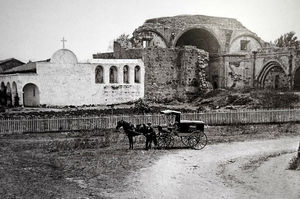
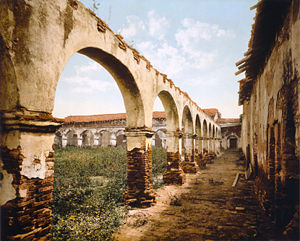
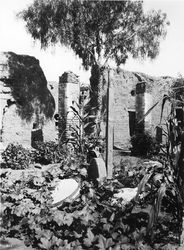
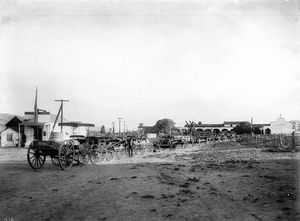

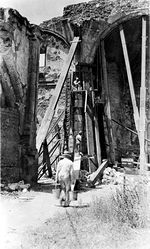
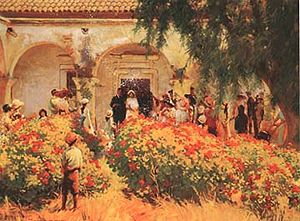

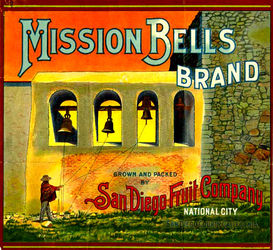
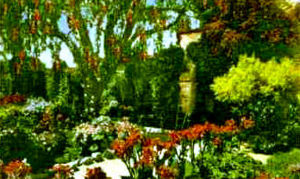
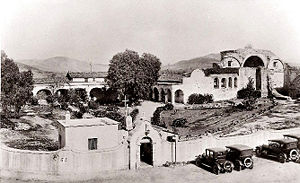
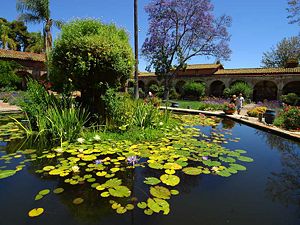
![(PD) Photo: San Juan Capistrano Historical Society Mary Astor and Gilbert Roland starred in George Fitzmaurice's 1927 motion picture Rose of the Golden West, shot on location on the Mission grounds.[9] The film's penultimate scene (shown here) is set amidst the ruins of "The Great Stone Church."](/wiki/images/thumb/8/8b/Rose_of_the_Golden_West.jpg/300px-Rose_of_the_Golden_West.jpg)
![(CC) Photo: Robert A. Estremo This 2nd-story refectory and bell tower was constructed atop the former carpentry shop on the north wing of the Mission's quadrangle in 1936.[10]](/wiki/images/thumb/2/2d/Mission_SJC_Refectory.jpg/300px-Mission_SJC_Refectory.jpg)
